


BHS ->Mr. Stanbrough -> Physics -> About Science -> this page
Not everyone from 300 B.C. to 1600 A.D. was willing to bow to the authority of Aristotle. Many of Aristotle's arguments were faulty, but where did he go wrong, and what was the right way to proceed?
|
|
|
|
 |
|
|
 |
|
|
In order to use the deductive method, you need to start with axioms - simple true statements about the way the world works. Then you use these axioms to build your logical system of nature. If your axioms are true, everything that follows will be true, but Galileo and his contemporaries realized that the problem was that it was enormously difficult to determine "simple true statements about the way the world works". In fact, they realized that it should be the goal of science - not the starting place - to determine what the "simple true statements about the way the world works" really are!
Since 1600, the inductive method has been incredibly successful in investigating nature - surely far more successful than its originators could have imagined. The inductive method of investigation has become so entrenched in science that it is often referred to as the scientific method.
The inductive method (usually called the scientific method) is the deductive method "turned upside down". The deductive method starts with a few true statements (axioms) with the goal of proving many true statements (theorems) that logically follow from them. The inductive method starts with many observations of nature, with the goal of finding a few, powerful statements about how nature works (laws and theories).
In the deductive method, logic is the authority. If a statement follows logically from the axioms of the system, it must be true. In the scientific method, observation of nature is the authority. If an idea conflicts with what happens in nature, the idea must be changed or abandoned.
Here is a diagram that attempts to depict the scientific (inductive) method. It is oversimplified and incomplete, but...

On the previous page, you learned that although mathematics is deductive in nature - that is, logical proof is the only acceptable evidence of truth - the process of mathematics is not entirely deductive. It is also true that although science is inductive by nature - observations are the only acceptable evidence of truth - the process of science can be deductive!
In particular, physicists make extensive use of mathematics as a powerful theoretical tool. Theoretical physicists often construct theories as "mathematical models" deductively, starting with assumptions about the inner workings of stars or atoms, for instance, and then working out the mathematical consequences of their assumptions. An essential difference between a mathematician and a theoretical physicist is that the physicist uses mathematics as a reasoning tool. The success of the mathematical model depends on how well its results agree with observations of nature - if they do not agree the physicist knows that this means that her assumptions - not the observations - need to be adjusted.
BHS -> Mr. Stanbrough -> Physics -> About Science -> this page